…and you could use the income
A recent poll found that 92% of American elementary school teachers would like to be using more music in their teaching.
(It engages kids, helps make the learning fun, and reaches diverse types of students.)
And according to PayScale.com, the average musician or singer in the United States earns just $40,957 a year – and that’s before taxes, insurance, equipment, other expenses, and COVID!
I see a big opportunity here. Do you?
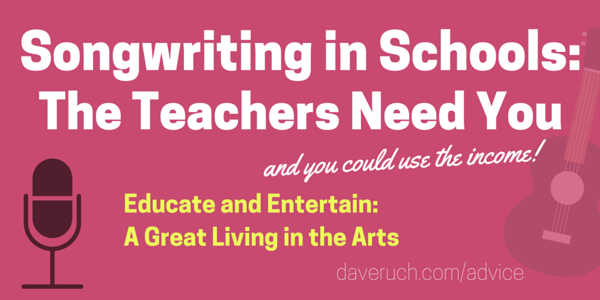 I’ll never forget my first songwriting experience with a group of kids, circa 1999.
I’ll never forget my first songwriting experience with a group of kids, circa 1999.
The fourth graders at Anna Merritt Elementary School were learning about the Native Americans of New York State, and I guided them in the creation of a 12-bar blues song about the tragic relocation of the Haudenosaunee tribes to the reservations.
It was a huge leap of faith on my part.
The way I decided to structure the project, I had no idea how the song would turn out, and there was at least a decent chance it would be a complete train wreck.
 My Method (circa 1999)
My Method (circa 1999)
How to approach this? I decided I’d teach the kids how a twelve-bar blues song is structured, showing them how the first line repeats and pointing out where the rhymes typically occur.
From there, I’d give them a five word start to the chorus (you guessed it, right? – “I’ve got the reservation blues”), use THEIR knowledge and THEIR words to inform the content of the song, and then, cross my fingers and pray.
With any luck, we’d end up with a chorus and couple of verses, and we could sing their new masterpiece right there on the spot.
Oh, and this was all to happen in 40 minutes.
 How Did It Go?
How Did It Go?
You know, it didn’t suck! In fact, it went pretty well (and it’s gotten a little better each time since).
My Takeaways
Most importantly, I learned a bunch of things that day:
- Music gets students excited (At least, in the classroom it does – bring a guitar to the playground and it’s a different story….)
- Music very often reaches the kids who are the most difficult for the teachers to engage
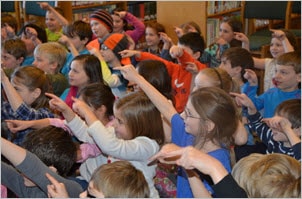 Students want to contribute to the creation of the song (which forces them to actually think about the topic)
Students want to contribute to the creation of the song (which forces them to actually think about the topic)- They love seeing their lyrics added to the song, and love singing the song because it’s in their words
- They learn new things about the topic without even trying because they’re having fun
- The song sticks around for a long time after I leave; same for any facts we managed to get in there
Can you see why 92% of elementary teachers would want to be using more music in the classroom?
What The Experts Say
I’m going to share as much as I can about getting, doing, and making a solid living from this meaningful work.
(Did I mention that musicians are getting from $250/day to $2,000/day to do this?)
As a solo performer though, so much of my work is done in a vacuum. It’s really rare that I get to watch others do what I do.
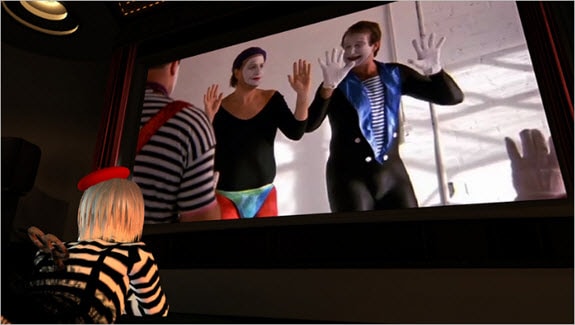 So, I’ve also reached out to several other veteran musicians who’ve been doing parallel work “in the trenches;” you’ll be hearing their perspectives too.
So, I’ve also reached out to several other veteran musicians who’ve been doing parallel work “in the trenches;” you’ll be hearing their perspectives too.
How to Write Songs With Kids
As If There Was One Way!
Your approach is going to depend a whole lot on how much time you have to work with the kids, how many times you’ll be seeing them, and how much they know about the topic before you arrive.
For me, I’m often starting, completing, and recording a song all within a single 40-60 minute session, so the twelve-bar blues method described above has been a mainstay.
I also frequently use the “parody” approach of borrowing the melody of a well-known pop or traditional song and creating new lyrics from there. (It was good enough for Francis Scott Key.)
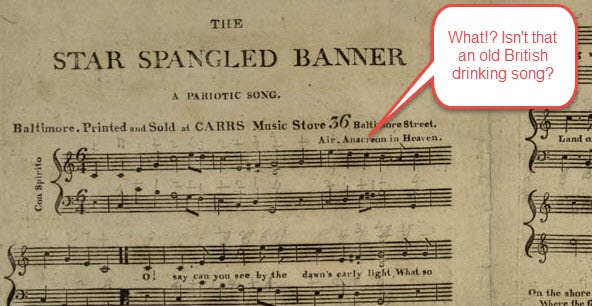 I also love to help kids write songs from scratch – words and music – when time is on my side (which it usually isn’t).
I also love to help kids write songs from scratch – words and music – when time is on my side (which it usually isn’t).
I detailed each of these methods in an article I wrote for teachers called “How to Write Songs With Your Students (for the non-musical classroom teacher).” You’re very welcome to borrow one or more of these approaches – I wasn’t the first to use them, and you won’t be the last.
Bill Harley is a Grammy-winning songwriter, performer, storyteller, and author who has performed in over 2,500 schools in 49 states and overseas. Here’s how he likes to do it:
 “I usually lay out a couple of structures – both in terms of form (ABAB, AABA, Blues) and also talk about simple rhyme schemes in verses and choruses. Then we look for the line that’s going to get repeated – the hook, or title of the song, and build the chorus around that. I MIGHT work on a melody line with them, emphasizing having the sung line enhancing the melody of the line as it’s spoken. We write chorus first, then have a discussion about what the verses are – what kind of story we’re telling. You have to work on them to not use a word just because it rhymes – meaning and rhythm have to be maintained.”
“I usually lay out a couple of structures – both in terms of form (ABAB, AABA, Blues) and also talk about simple rhyme schemes in verses and choruses. Then we look for the line that’s going to get repeated – the hook, or title of the song, and build the chorus around that. I MIGHT work on a melody line with them, emphasizing having the sung line enhancing the melody of the line as it’s spoken. We write chorus first, then have a discussion about what the verses are – what kind of story we’re telling. You have to work on them to not use a word just because it rhymes – meaning and rhythm have to be maintained.”
Maine-based writer, musician, and teacher Josephine Cameron takes a nimble, project-based approach to songwriting with kids:
 “Really, (the method I use) depends on the size, age, and objective of the group. What works with a small, focused group over a week-long residency is very different than what will be successful with a 40-minute large class. Sometimes we write an entire song as a collaborative group, sometimes we write a chorus together then break up into smaller groups for verses, and sometimes we do individual work. No matter what, I like to make sure there is always some full-group collaboration. Working together breeds innovative, surprising results. I love that! Typically, I find it easier to work on lyrics first, then melody. I like to offer chord and rhythm suggestions on the guitar, and let the students choose the sounds they like best.”
“Really, (the method I use) depends on the size, age, and objective of the group. What works with a small, focused group over a week-long residency is very different than what will be successful with a 40-minute large class. Sometimes we write an entire song as a collaborative group, sometimes we write a chorus together then break up into smaller groups for verses, and sometimes we do individual work. No matter what, I like to make sure there is always some full-group collaboration. Working together breeds innovative, surprising results. I love that! Typically, I find it easier to work on lyrics first, then melody. I like to offer chord and rhythm suggestions on the guitar, and let the students choose the sounds they like best.”
Chip Richter is a singer-songwriter from Ohio who specializes in music for kids and families. Chip’s projects are somewhat different from all of the above, and take place over a three-day period:
 “I typically don’t write with them (students) as much as spend my time helping them discover what makes a song work. My workshop is a three day process, one class period each day. The first two days we are taking apart a song, discovering those elements and listening to some songs for examples. I’ll either perform some of my songs or play mp3s of popular songs students may have already heard. After two days of taking a song all apart, I give the students homework for the third day. I ask them to take some of what they have learned and craft their own lyric. I’m not looking for a finished song; just a good start. On the third day we spend the entire workshop reading and talking about the lyrics the students have crafted. I’m always amazed at what kids come up with. I feel like my job is to teach something about how songs come together and then empower kids to try it themselves.”
“I typically don’t write with them (students) as much as spend my time helping them discover what makes a song work. My workshop is a three day process, one class period each day. The first two days we are taking apart a song, discovering those elements and listening to some songs for examples. I’ll either perform some of my songs or play mp3s of popular songs students may have already heard. After two days of taking a song all apart, I give the students homework for the third day. I ask them to take some of what they have learned and craft their own lyric. I’m not looking for a finished song; just a good start. On the third day we spend the entire workshop reading and talking about the lyrics the students have crafted. I’m always amazed at what kids come up with. I feel like my job is to teach something about how songs come together and then empower kids to try it themselves.”
Musician and former school teacher Marla Lewis, whose two albums for kids have won Parents’ Choice and NAPPA Gold Awards, likes to have the kids start in advance of her visit to the school:
 “Before I even arrive, I have the class decide what they want to write about (and) tell them to create a word web around that topic. We (then) look at that web and add more ideas to it. I tell kids we are using our right brains now: no judgement, just flow of ideas. The teacher acts as scribe so I can call on the kids. We get lots of ideas! Then I say ‘now’ s the time to use our left brain, the editor, and look at what we have. What’s this song about?’ That’s your main idea, the Chorus. We also use our ‘editors’ to take a vote on which ideas the class as a whole liked best. Once we decide what the song will be about, we generate a chorus together.”
“Before I even arrive, I have the class decide what they want to write about (and) tell them to create a word web around that topic. We (then) look at that web and add more ideas to it. I tell kids we are using our right brains now: no judgement, just flow of ideas. The teacher acts as scribe so I can call on the kids. We get lots of ideas! Then I say ‘now’ s the time to use our left brain, the editor, and look at what we have. What’s this song about?’ That’s your main idea, the Chorus. We also use our ‘editors’ to take a vote on which ideas the class as a whole liked best. Once we decide what the song will be about, we generate a chorus together.”
Monty Harper of Stillwater Oklahoma has done projects ranging in length from one single session to nine visits over as many days. He said:
 “We usually start by brainstorming on the theme, which leads us to a concept or a title. This often becomes a chorus, then I have them start adding melody and we organize thoughts into supporting verses. Often one or two kids are talented at creating melody and we build on what they suggest. If not, we might decide on a rhythm, then “sing” it together as a group along with some guitar chords. Usually a melody emerges. I never use an existing melody. That can feel constraining and lead to lines that are insincere or unclear. Also, I want my students to experience the entire songwriting process. I set a goal for each writing session and walk into class knowing how I’m going to collect students’ ideas toward reaching that goal. I also walk in prepared to change tactics if needed. Without my help, students won’t complete a song they all feel proud of, but if they get too much help, students won’t feel ownership of their song. I work hard to find the right balance with each group.”
“We usually start by brainstorming on the theme, which leads us to a concept or a title. This often becomes a chorus, then I have them start adding melody and we organize thoughts into supporting verses. Often one or two kids are talented at creating melody and we build on what they suggest. If not, we might decide on a rhythm, then “sing” it together as a group along with some guitar chords. Usually a melody emerges. I never use an existing melody. That can feel constraining and lead to lines that are insincere or unclear. Also, I want my students to experience the entire songwriting process. I set a goal for each writing session and walk into class knowing how I’m going to collect students’ ideas toward reaching that goal. I also walk in prepared to change tactics if needed. Without my help, students won’t complete a song they all feel proud of, but if they get too much help, students won’t feel ownership of their song. I work hard to find the right balance with each group.”
Through the Kid Pan Alley program, Paul Reisler has helped children write more than 2,700 songs. Like Monty Harper, Paul starts with a clean slate and uses a very democratic process:
 “(I like) to give the kids the experience of starting from the blank page and carrying it all the way through to a recording and performance, so we don’t start with pre-existing music, an idea of what we want to write about, a rhyme scheme, or form. It is the blank page. Once we have picked (a topic), we brainstorm, writing all their ideas down. Once we see a general direction, we start writing a section of lyric, (then) we get the melody from them by finding the natural pitch and rhythm of the way they would speak it. We clap the rhythm together and use our hands to show relative pitch, then we ask a couple of them to try singing the first line. We vote on the one we think most fits the lyric and then I play it for them in several styles on the guitar and they choose which one most evokes the essence of the song. We go through the section line by line that way, always singing our way to the next line so that it flows naturally. After that we write a contrasting section and go through that in the same way. Often the songs also have a bridge.”
“(I like) to give the kids the experience of starting from the blank page and carrying it all the way through to a recording and performance, so we don’t start with pre-existing music, an idea of what we want to write about, a rhyme scheme, or form. It is the blank page. Once we have picked (a topic), we brainstorm, writing all their ideas down. Once we see a general direction, we start writing a section of lyric, (then) we get the melody from them by finding the natural pitch and rhythm of the way they would speak it. We clap the rhythm together and use our hands to show relative pitch, then we ask a couple of them to try singing the first line. We vote on the one we think most fits the lyric and then I play it for them in several styles on the guitar and they choose which one most evokes the essence of the song. We go through the section line by line that way, always singing our way to the next line so that it flows naturally. After that we write a contrasting section and go through that in the same way. Often the songs also have a bridge.”
You can check out Paul and the Kid Pan Alley program in this video:
Song Content: What to Write About?
For me, this is always about curriculum. The days of schools parting with their two scarcest resources – instructional time and money – to bring in an artist just because it’s a great thing to do seem to be just about over, at least here in the northeastern USA.
(And when they do, the teachers often resent it – there’s just too much on their plates right now.)
The good news is that, as detailed in the article How to Get Gigs in Schools, tying your songwriting themes to the actual stuff they’re already working on in the classroom is a really winning formula.
So, I’ve made it a point to investigate the curriculum in my home state, by grade level and by subject, looking for the topics that are most interesting to me.
THAT’s what I write songs about with students.
 You may not be surprised, however, to learn that others do it differently!
You may not be surprised, however, to learn that others do it differently!
I asked Paul Reisler about the topics he writes about with kids:
“We get a list of about 20 ideas from the students and then we vote on it. There are songs about everything imaginable from adoption to alzheimer’s, from having a messy room to taking care of the earth. We’ve written so many incredible love songs with elementary school children that I want to do an album named after one of the songs—“Third Graders Don’t Write Love Songs.” But they do—deep, surprising love songs that go way past what most adults write in love songs.”
Bill Harley said:
“I usually brainstorm a bunch of topics with kids, then have them vote – two passes of voting, until we get down to two or three. Before the final vote, we spend some time fleshing out what the songs might be about – this advance work ensures that they’re invested and that we have something to work with. I will exclude titles that aren’t going to work or going to cause problems, even if they’re excited about them.”
Marla Lewis keeps it loose too:
“Anything and everything…whatever they’re studying, or whatever the mood. I’m working on a skeleton song with 5th graders now; last year, I worked with an entire second grade and we wrote five songs about spring. With a fourth grade class we wrote about the joy of realizing that School’s Out!”
Some of Josephine Cameron‘s topics sound similar to mine (except the underwear part….):
“Everything under the sun! If the program I’m teaching is focused on a specific time period or songwriter, we will choose a topic or song structure that is ‘in the spirit of’ the traditional songs we are working on. When I am teaching Songs of the Civil War Era, for instance, we might come up with a rallying cry, or a song that tries to persuade others, or a tragic ballad that tugs at the heart-strings (all popular musical forms during the Civil War Era). When I am teaching Songs of the Civil Rights Movement, we write protest songs, of course! If the workshop is on the Blues, we write songs about things that make us mad, sad, or drive us crazy. I’ve seen song topics that range from school anthems to the Iraq war to volcanic eruptions to falling out of bed. Did I mention the song about polkadot underwear?”
Monty Harper keeps it relevant to the school environment:
“I like to find some kind of community or curriculum connection so that our songs will have a purpose. Some of my favorite examples from past residencies include: songs for fifth grade graduation, songs used to promote a local recycling program, songs inspired by the book City of Ember, and songs inspired by a visit from two scientists – which we then used to help the scientists present their research to the public!”
Keep it Positive!
It goes without saying that kids will feel more at ease and be more invested in contributing to the song if they feel respected, encouraged, and supported.
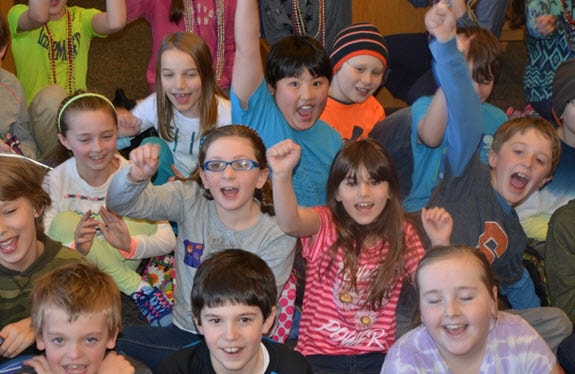 I always make it a point to say “there are no wrong answers – we’re going to take every single idea and work with it,” and I’ll go out of my way to draw something – anything – out of that shy kid who looks like they might want to chime in. No contribution is too small.
I always make it a point to say “there are no wrong answers – we’re going to take every single idea and work with it,” and I’ll go out of my way to draw something – anything – out of that shy kid who looks like they might want to chime in. No contribution is too small.
The late Penny Nichols, former Executive Director of SummerSongs adult songwriting camp, once reminded me of just how important this can be:
 “One of the main issues that comes up continuously with our adult campers is the years of therapy and healing that has to take place to undo the damage caused by bad teachers in the early years telling them not to sing or that they sing badly. People can learn how to sing, play, write songs, etc. but it’s much harder if a person is carrying around a lot of negative input and grief about not being allowed to express themselves as children. Every human has a right to self expression. Period.”
“One of the main issues that comes up continuously with our adult campers is the years of therapy and healing that has to take place to undo the damage caused by bad teachers in the early years telling them not to sing or that they sing badly. People can learn how to sing, play, write songs, etc. but it’s much harder if a person is carrying around a lot of negative input and grief about not being allowed to express themselves as children. Every human has a right to self expression. Period.”
Ready for Part II?
In the second half of this article, we discuss:
- how to get the gigs
- how much to charge
- tips from the pros
Click here to read Part II: How to Make Money Writing Songs in Schools
In the meantime, I hope this has sparked some new ideas for you. Have you done any songwriting with kids? Thinking about it? The comments section is just below.
About The Blog
 Since leaving a white-collar marketing job in 1992, Dave Ruch has been educating and entertaining full-time in schools, historical societies and museums, folk music and concert venues, libraries, and online via distance learning programs.
Since leaving a white-collar marketing job in 1992, Dave Ruch has been educating and entertaining full-time in schools, historical societies and museums, folk music and concert venues, libraries, and online via distance learning programs.
Along the way, he’s learned a great deal about supporting a family of four as a musician.
The Educate and Entertain blog provides articles, tips, encouragements, and how-to’s for regional performers (in any region) interested in making a great full-time living in the arts.


Great read.
I’ve been mentoring/teaching Hit songwriting for many years. Love it! Have had a handful of Billboard #1 students/artists/clients.
Thank you for this insightful article.
Dave great article. I am thinking about trying this. Have you ever come into a situation that someone wanted to use one of the songs created with the kids.
Who owns the rights?
Technically work for hire ? I know I’m getting ahead of myself but question popped into my head as I was writing this.
Hey Stephen – good question, I don’t think that far ahead! But no, in 20+ years of doing this I’ve never come across that situation. The songs are mostly for educational purposes, and the kids get a kick out of hearing the recorded end product, but that’s as far as it tends to go. Paul Reisler (quoted in the article) might have more experience with that – feel free to reach out to him via his website.
I am about to embark on a journey into teaching kindie music classes as well as hopefully breaking into the world of school assemblies and such 🙂 Great article (as always) and I KNOW I will be using a lot of this advice.
Great to hear that Nathan! Keep us posted…
any way to do this without hundreds of hours of computer work?
Hi Richard – getting the gigs is an ongoing process, for sure, and a significant amount of marketing time is required. If you’re more comfortable on the phone than behind a computer, that can be a really effective way to reach out to schools too. Part 2 of this article (linked above and below) gets into how to reach out to schools, and other ways to get these gigs. Getting listed on arts in ed rosters and doing artist showcases are two ways to get the ball rolling without a ton of marketing time.